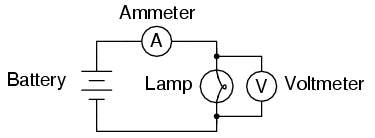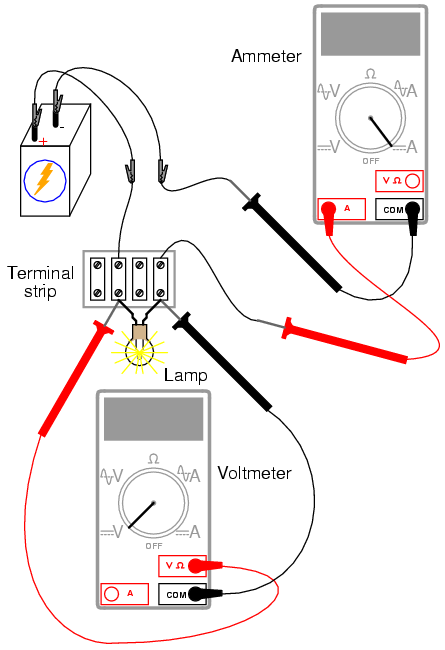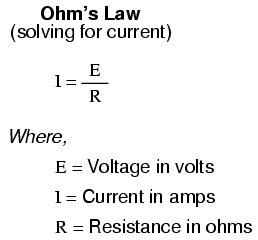Nonlinear resistance
PARTS AND MATERIALS
CROSS-REFERENCES
Lessons In Electric Circuits, Volume
1, chapter 2: "Ohm's Law"
LEARNING OBJECTIVES
SCHEMATIC DIAGRAM

ILLUSTRATION

INSTRUCTIONS
Measure the resistance of the lamp with your
multimeter. This resistance figure is due to the thin metal
"filament" inside the lamp. It has substantially more
resistance than a jumper wire, but less than any of the
resistors from the last experiment. Record this resistance
value for future use.
Build a one-battery, one-lamp circuit. Set
your multimeter to the appropriate voltage range and measure
voltage across the lamp as it is energized (lit). Record
this voltage value along with the resistance value
previously measured.
Set your multimeter to the highest current
range available. Break the circuit and connect the ammeter
within that break, so it becomes a part of the circuit, in
series with the battery and lamp. Select the best current
range: whichever one gives the strongest meter indication
without over-ranging the meter. If your multimeter is
autoranging, of course, you need not bother with setting
ranges. Record this current value along with the resistance
and voltage values previously recorded.
Taking the measured figures for voltage and
resistance, use the Ohm's Law equation to calculate circuit
current. Compare this calculated figure with the measured
figure for circuit current:

What you should find is a marked difference
between measured current and calculated current: the
calculated figure is much greater. Why is this?
To make things more interesting, try
measuring the lamp's resistance again, this time using a
different model of meter. You will need to disconnect the
lamp from the battery circuit in order to obtain a
resistance reading, because voltages outside of the meter
interfere with resistance measurement. This is a general
rule that should be remembered: measure resistance only on
an unpowered component!
Using a different ohmmeter, the lamp will
probably register as a different value of resistance.
Usually, analog meters give higher lamp resistance readings
than digital meters.
This behavior is very different from that of
the resistors in the last experiment. Why? What factor(s)
might influence the resistance of the lamp filament, and how
might those factors be different between conditions of lit
and unlit, or between resistance measurements taken with
different types of meters?
This problem is a good test case for the
application of scientific method. Once you've thought of a
possible reason for the lamp's resistance changing between
lit and unlit conditions, try to duplicate that cause by
some other means. For example, if you think the lamp
resistance might change as it is exposed to light (its own
light, when lit), and that this accounts for the difference
between the measured and calculated circuit currents, try
exposing the lamp to an external source of light while
measuring its resistance. If you measure substantial
resistance change as a result of light exposure, then your
hypothesis has some evidential support. If not, then your
hypothesis has been falsified, and another cause must be
responsible for the change in circuit current.
|